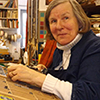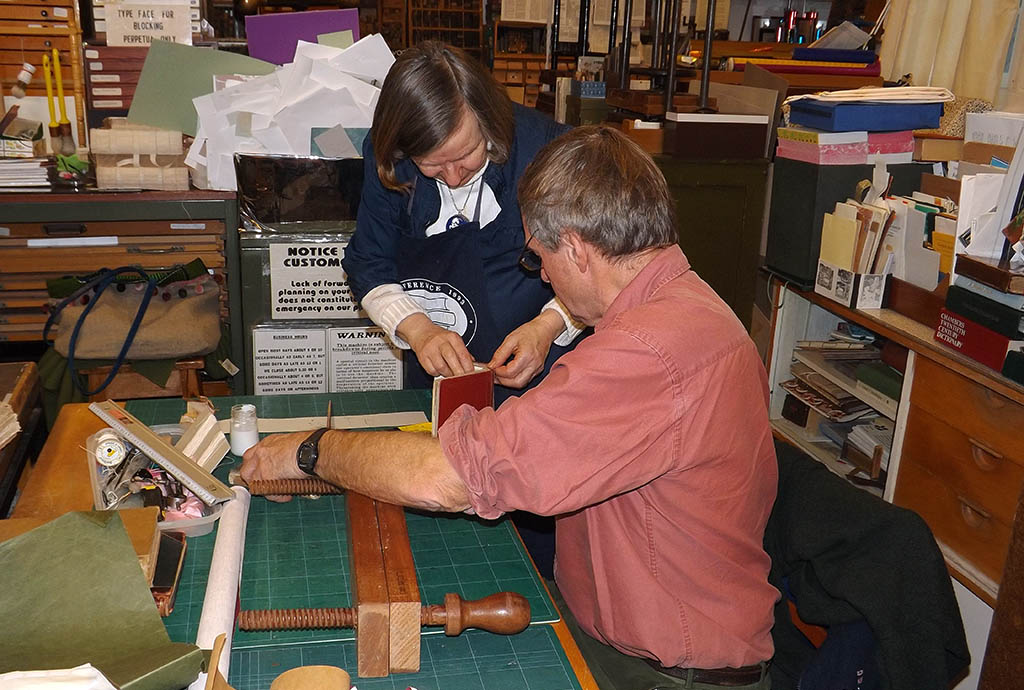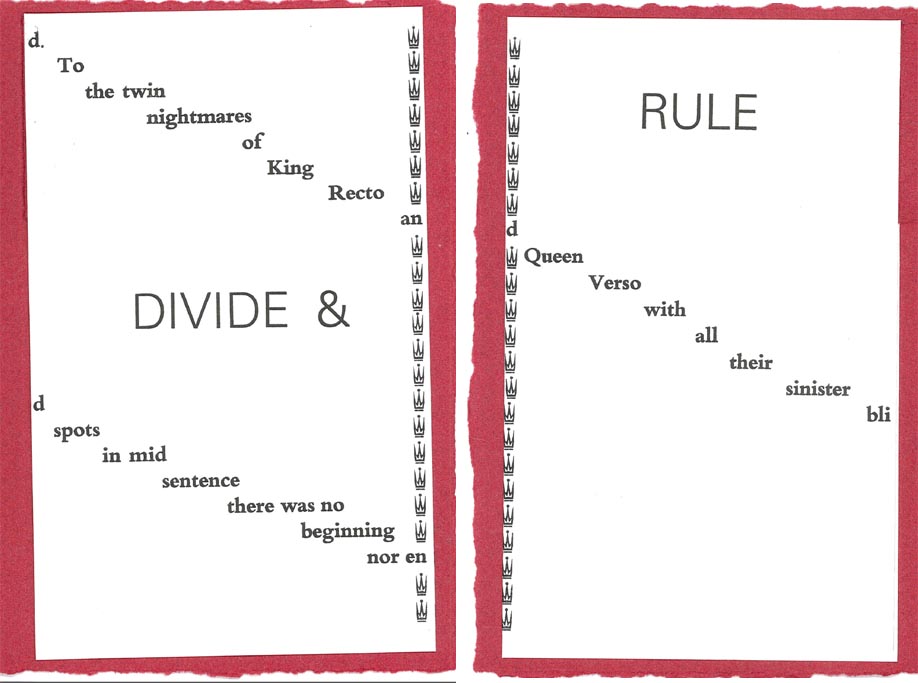 Mary Bartlett came to Dartington in 1963 as a horticultural student. After her training she became responsible for the glasshouses, nursery and walled garden.
Mary Bartlett came to Dartington in 1963 as a horticultural student. After her training she became responsible for the glasshouses, nursery and walled garden.
She is the author of several books, including the monograph Gentians, and Inky Rags, a review of which can be found on the Dartington website. She is now the tutor for bookbinding, part of the Crafted @ Dartington programme. More blogs from Mary
It’s heartening to see signs that Dartington is re-investing in the crafts, and encouraging to think the Dartington tradition that once contributed so much to the survival of craftsmanship in Britain might be being rediscovered.
My own experience of craftsmanship began in my relationship with Eric McNally, the founding Dartington bookbinder. Bookbinding at Dartington was already about 40 years old when I met him and is 80 years old now.
It sounds like an awfully long time. To young years it probably all sounds tediously of the past. But luckily for me and for all the people who come to my classes and learn with me what I learned from ‘Mc’, very long practice is still the key to good work.
In his 2008 study, The Craftsman, the social theorist, cultural historian and Juilliard school musician, Richard Sennett, famously prescribed 10,000 hours of practice as the necessary requirement for crafts expertise. So, let’s see: six hours a day, 30 hours a week, 120 hours a month, 1,200 hours a year – that makes eight and a half years of solid work to become a half-decent maker. Or 104 years at weekly evening class. Or every weekend down in garden shed for about 20 years.

The odd thing is – I doubt anyone who works with me in the bindery will be surprised by these numbers. As soon as any of us embarks on a project, two thoughts spring to mind: firstly, it will me take me years to get this right; secondly, so help me, I’m going to get this right before I die.
And, equally, when we make something extraordinary together, for example the Printmakers Flora that combined the skills of Dartington Bookbinders and Printmakers in 1996 and which earned itself a place in the Yale Center for British Art – the long hours invested in such a collaboration become invisible and at the same time unmistakable. Immanence might be the word for the quality the long hours bring to art.
One of Richard Sennett’s themes in The Craftsman is the value of a particular kind of teacher and the importance of what nowadays gets called knowledge transfer. He offers as an example the history of Antonio Stradivari’s violin workshop in Cremona. Sennett argues that while craftsmanship of the highest genius was practised there, the Master lacked the expertise to guarantee that it would endure without him – in his absence, or after his death.
The decline of the Stradivari workshop illustrates a critical distinction, Sennett writes, between the sociable and the antisocial expert. “A well-crafted institution will favour the sociable expert; the isolated expert sends a warning signal that the organization is in trouble.”
There’s a lot in that observation! And he says more. Antisocial expertise emphasizes inequality. It preoccupies itself with the difference between the stupid and the smart, arousing humiliation and resentment. Sociable expertise puts originality and repair on the same plain: it encourages and advises; it relishes “the thousand little everyday moves that add up in sum to a practice”.
It might have been written by an Elmhirst.
Because of Mc’s priceless gift to me of an interest in bookbinding, I got to know the late Roy Harris. Roy was Emeritus Professor of General Linguistics at Oxford and expert in fields I barely knew the name of when he first came to my class to learn the rudiments of typesetting and binding.
Later on, he paid me, my patient Master Mc – and craftsmanship in general – this wonderful tribute: “Mary made me realise, to an extent I had never appreciated before, how even the smallest detail of practical hands-on execution can have significant theoretical implications… This is one of the most important lessons I have ever learned in my academic life, and I doubt whether I should have learned it at all had I never happened to set foot in Mary’s type-laden workshop.”
So there you are: from Richard Sennett and Roy Harris, words to bring us craftsmen and women comfort in our old age. Worth waiting 10,000 hours to hear them!
Mary
Mary’s most recent collaboration is with the Russian book artist Dmitry Sayenko. They have been making an illustrated book together about another of her abiding passions, the Unicorn, First copies are due any day in the post – from Dmitry’s workshop in St. Petersburg.
The Craftsman by Richard Sennett is published in paperback in the UK by Penguin Books.


Mary,Is there anywhere at Dartington would have records of students on the horticulture course between 1969 to 1972.I have lost the names. Thank you. John Burdett
Dear John,
I am not sure if they would be in the Devon records office at Exeter where the Trust records are now kept.
You could try Terry Underhill as he well remember.
Although I was still working in the department I have no records.
You could try contacting the Trust archivist Yvonne Widger.
She usually works on a Tuesday and if you rang in they would be able to put you in touch.
Best wishes,
Mary
Lovely blog, Mary, the meaning underlined for me by a visit to one of your classes, where everyone was intent and quietly working, but a great sense of a real group, not just individuals who happened to be gathered together for a particular reason. I keep meeting people who say, “I’m starting in one of Mary’s classes, can’t wait.”
(Sarah)
Could you please pass this to Tattwa Gyani (Sarah)? I have been asked to write an obituary of her mother for The Times, and would very much like to speak to her. Unfortunately the Orchards Live link does not work.
Huon Mallalieu
020 7249 5341
07866298800
Dear Tattwa Gyani I would like to have a copy of your Yoga Water Purge that you taught us years ago. Any chance?
Sociable expertise also requires the shifting over of the ego and desire for status. In the community sector, for example, there are many organisations set up in response to real needs, where the founder works hard to establish a viable enterprise and acquires huge reservoirs of knowledge, contacts, skills etc – but if they see themselves as being central to everything, feel it’s ‘their thing’, and don’t have the vision and commitment to share expertise, the organisation is basically unsustainable and can fail when this person either burns out or leaves.
‘ Antisocial expertise emphasizes inequality. It preoccupies itself with the difference between the stupid and the smart, arousing humiliation and resentment. Sociable expertise puts originality and repair on the same plain: it encourages and advises; it relishes “the thousand little everyday moves that add up in sum to a practice”.’
Give me sociable expertise any day!
Thank you Mary for your observations.
Dear Chris,
Thank you for your comment. I am glad it helped. With five classes a week that is 40-50 people who come each week to make. Each time there are still things I have not seen and technical problems to sort out.
Mary Bartlett
In just reading those words alone, a subtle understanding has been passed on to me. Thanks Mary.
Dear Robin,
Thanks as always. You also know well the effort of making things.
All best wishes,
Mary